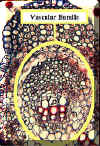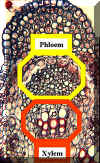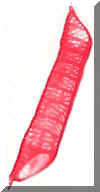 Cross-Section of a Dicot Stem - Cells in the Xylem have stained red for lignin. Xylem and Phloem are the Vascular Tissues in plants. They are usually found together. Most people are familiar with vascular tissues in stems. Thus we will start with stem cross-sections. The vascular tissues in stems are found within tubular bundles which are continuous over a relatively large distance. Cells in the xylem have thick lignified walls which stain red for lignin in most preparations. |
|||
|
Both Xylem and Phloem have cytological traits which distinguish them from the surrounding Ground Tissues. The Lignified walls of the Tracheary Elements in the Xylem are the most distinctive of these. Xylem & Phloem are said to be "complex tissues" because they contain Fibers and Parenchyma as well as Tracheary Elements (Xylem) & Sieve Elements (Phloem). | ||
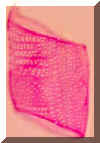 Wide Vessel member with a simple Perforation Plate. This kind of cell is better for conduction than physical support. |
|||
| The most specialized cells of the Xylem are called Tracheary Elements. These serve two functions, physical support & water conduction. Vessel Members (VM) have large openings in their end walls. These are the "Perforation Plates". The most advanced VM have no wall obstructions between succeeding members of a Vessel. These have "Simple Perforation Plates". Both of the cells on the left have simple Perforation Plates. Elongated cells with narrow bores are better for support. Shorter wider cells are better for conduction. Tracheary Elements also contain many pits on their side walls. | |||
 Note the ladder-like (scalaraform) segments of cell wall which form the Perforation Plate on the endwall of this Vessel Member. I used an embossing tool to generate the image on the right. |
|||
Tracheids
are the other type of Tracheary Element. 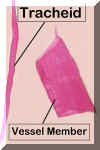 Tracheids are usually more elongate and
narrower than Vessel Members. However, the most critical difference is that tracheids are Imperforate. This means that they lack
Perforation Plates. Their end walls contain numerous pits, however, which
facilitate the longitudinal transport of water. Vessel Members are characteristic for
Angiosperms but are rare in non-flowering terrestrial plants. The most advanced
angiosperms have both types of tracheary elements in their xylem. Tracheids are usually more elongate and
narrower than Vessel Members. However, the most critical difference is that tracheids are Imperforate. This means that they lack
Perforation Plates. Their end walls contain numerous pits, however, which
facilitate the longitudinal transport of water. Vessel Members are characteristic for
Angiosperms but are rare in non-flowering terrestrial plants. The most advanced
angiosperms have both types of tracheary elements in their xylem. |
|||
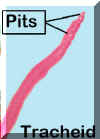 Tracheid endwalls only contain Pits. |
|||
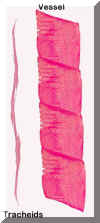 Comparison of Tracheids and Vessel Members combined in a vertical column. A Vessel is composed of several Vessel Members. There is no collective term for a longitudinal series of Tracheids. The disparity in radial and longitudinal sizes demonstrate that Tracheids can supply more structural support than Vessels & that Vessels can conduct more water. |
|||
 Lecture Directory |
 Anatomy Home Page |
Next Page |
|
|---|---|---|---|
